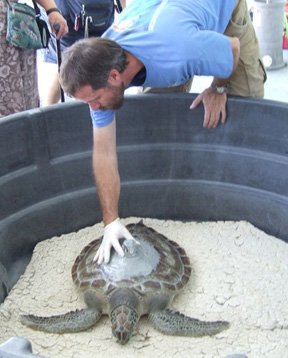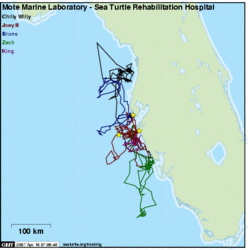

 |
||||||
 |
||||||
Where the Boys Are
Researchers Enjoy a Rare Opportunity to Track Male Turtles
By Victoria Parsons
When talk turns to sea turtles, most of us envision tiny hatchlings scrambling across sandy beaches for the relative safety of the sea or giant females lumbering ashore to lay eggs on the same beach where they were born.
But little is known about what happens to a sea turtle in the time between those events – perhaps 30 years later. Still less is known about male turtles that never return to land after leaving their natal beach.
Except this year, when turtle nesting season kicks off on May 1 researchers at Mote Marine Laboratory will know exactly where the boys are – at least some of them.
 |
| Photos courtesy Mote Marine Laboratories Tony Tucker carefully places a satellite transmitter on the back of a sea turtle before it is released. |
“Right now, they’re near our shorelines looking for a date,” says Tony Tucker in late March. “It is evident that they’re hanging around the passes waiting for the females to return.”
Four male turtles – including three survivors from last year’s red tide outbreaks – now sport satellite transmitters that report their locations to researchers. “This is a rare opportunity to track males,” adds Tucker, manager of Mote’s sea turtle conservation and research program.
Already the difference in ranges is obvious. Released between November and late March, the male turtles have stayed closer to home than females tagged earlier who may forage as far as Mexico’s Yucatan Peninsula, up to a thousand miles away.
“The females are beginning to migrate back for the beginning of nesting season on May 1,” he says. “Depending upon where they’re coming from, they may have a three- to six-week swim.”
Transoceanic Tracks
Researchers have been tracking turtles for over 30 years, documenting multiple transoceanic journeys and diverse routes followed by different species. Most turtles that nest on Gulf beaches are loggerheads, which hatch here and then catch a ride on the Gulfstream to the Azores where they spend up to 10 to15 years growing until they’re about two feet long.
They return to the Gulf of Mexico on equatorial currents and hang around another 15 years before they’re ready to reproduce, which typically occurs when they reach about three feet rather than a specific age. Beyond those wide parameters, scientists are just beginning to learn where turtles are when they’re not on a beach nesting.
Tracking turtles offshore, however, isn’t an easy or inexpensive process. Tagging and tracking a single turtle with a satellite transmitter costs over $3,000 and lasts about a year. This year, funding from the sea turtle license tag will cover the cost of outfitting 16 turtles, more than ever before.
Also for the first time ever in Florida, scientists are tracking more than just where the turtles are. Several turtles will be outfitted with sensors that track levels of red tide, which can kill or cause serious illness in turtles.
 |
| They’re not quite the teen-age mutant ninja turtles that are capturing the hearts of kids across the country, but sea turtles outfitted with satellite transmitters certainly are a step up on the evolutionary chain. King, who was found floating lethargically near Casey Key, spent 11 months at Mote before he was released on March 29. He traveled about 175 miles in the first three weeks after he was released before ending up back near the coast in mid-April – just in time for nesting season to begin May 1. |
Along with the three males nursed back to health after being sickened by red tide, Mote researchers believe they lost a female turtle to the deadly algal bloom last summer. Arial – adopted by a third-grade class in Connecticut and named for Disney’s Little Mermaid – was found dead in an area with high concentrations of red tide.
“There isn’t a smoking gun but there’s a strong association between her death and a period of exposure to red tide,” Tucker said.
Over time, the turtle-mounted red tide sensors may provide an early warning system that alerts scientists when the toxic algae begins to concentrate offshore, Tucker adds, particularly if the males continue to swim the offshore routes they followed after being released last fall.
Female turtles, which may lay four or five clutches of eggs per season but only nest every two to four years, seem to have an extremely high tolerance for red tide, probably because it appears to be most dangerous to turtles when it is ingested. “As far as we can tell, nesting females aren’t foraging while they are nesting. However Arial was exposed to red tide after the nesting season, when she had probably resumed feeding,” Tucker notes.
Tracking Turtles Online
The technology that makes it happen is highly complex, but tracking turtles is easy enough for four-year-old children to follow their favorite animals via email.
“We get feedback from parents saying that the first thing they do when their children get up in the morning is turn on the computer to see where ‘their’ turtle is,” says Michael Coyne, the sea turtle researcher turned computer educator who runs www.seaturtle.org. “Often, if you can’t see an animal, you don’t know to worry about it – this allows people to ‘see’ turtles so they’re more involved.”
From an outreach perspective, online tracking allows children and landlubbers to share in the adventure from anywhere in the country, adds Tucker. “You learn what’s happening with the turtles as soon as I do so you can follow the adventure as a turtle diary unfolds.”
Coyne’s programming translates an enormous amount of data into easy-to-follow maps that detail the day-to-day travels of sea turtles from around the globe as well as birds and other animals. “In North Carolina, where I live, most people live a good way from the beach and don’t realize that sea turtles live off our shores,” he said. “This gives the kids across the country a chance to participate in sea turtle research and learn to respect the marine environment – and that their actions can have a large impact on that environment.”
 |
| Where the boys are: Four male turtles released over the past two months appear to be “homeboys” who stick close to the coast while females set off to explore the Gulf and Caribbean Sea. The male trails, however, cover less than 90 days of travel while the female tags have been transmitting data since last summer and those paths may change over time. Maps courtesy www.seaturtle.org |
 |
“Life in the Slow Lane”
While much remains to be discovered about sea turtles and their life cycles, fossil records indicate that the creatures themselves – the most primitive egg-bearing animals still in existence – have changed little in 200 million years.
Along with their survival skills as a species, individual turtles live extraordinarily long lives with no significant age-related health declines from reproductive senescence, Tucker says. “As far as we can tell, turtles continue to reproduce long beyond the 20- to 30-year careers of researchers studying them with no serious symptoms of declining health.”
In humans, a major symptom of aging is a reduction in the length of telomeres. That process doesn’t seem to occur in turtles that may live and continue reproducing for more than 100 years. “At least one sea turtle has been laying eggs here for 20 years,” Tucker said. “It won’t happen in the next five years, but we may learn something about genetics at the cellular level from turtles that may answer some critical questions about the human aging process.”
Survival Skills Less Effective Today
Those evolutionary factors, however, aren’t as effective in helping sea turtles survive modern-day challenges. Impacts to habitat, including beach erosion or “hardening” that restricts females from laying eggs and artificial lights that cause hatchlings to run toward land instead of the sea, are a growing problem in Florida, where most of the world’s loggerhead population nests.
One bright spot in sea turtle survival is the 97% success rate with turtle excluder devices – or TEDs — on shrimp nests that reduced loggerhead deaths from about 62,000 in 2000 to about 4,000 today. “The old TEDs were helpful but the new ones are much more effective,” says Bob Hoffman, a turtle expert at the National Marine Fisheries Service. The original TEDs were designed to protect Kemp-Ridley turtles, the most endangered but also the smallest, but the new openings will allow even the largest turtle to escape.
Around the world, however, sea turtles face ongoing dangers:
Simultaneous research being conducted with captive turtles at Mote is designed to determine what a turtle actually hears among the noises documented by underwater microphones. ‘We need to understand their hearing abilities to know what sounds may be important to them underwater,” Mann said.
|
"This gives the kids across the country a chance to participate in sea turtle reasearch and learn to respect the environment."
Michael Coyne |
Another challenge facing sea turtle researchers is the length of the turtle lifecycle – the hatchlings tagged on a beach this summer probably won’t return to the Gulf of Mexico for a dozen years and may not return to their natal beaches for decades.
Tracking migrations across oceans also is challenging, but learning more about how, why and when these creatures use migratory routes and habitats will be critical to protecting the species. “Marine turtles face threats during the 99% of their life cycle that occurs far from nesting beaches. Over time, tagging sea turtles will allow us to answer key management questions that could lead to new methods to safeguard them.”
Future of Florida Farming May Be Rising in Dover
Don Whyte: Greening the Vision of Development
Estuary Program Awards $160,000 in Community Grants
Mote's Founding Director Celebrates her 85th Birthday
The Pier Aquarium Prepares For its Grand, Grand, Grand Reopening